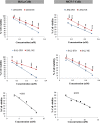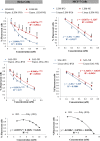Incorporation of ifosfamide into various essential oils -based nanoemulsions ameliorates its apoptotic effect in the cancers cells
- PMID: 30679649
- PMCID: PMC6346000
- DOI: 10.1038/s41598-018-37048-x
Incorporation of ifosfamide into various essential oils -based nanoemulsions ameliorates its apoptotic effect in the cancers cells
Abstract
The chemotherapeutic drugs, loaded in nanocarriers, have recently attracted the pharmaceutical industries due to their limited adverse side effects. The objective of the current study was to incorporate the ifosfamide (IFO) into two different essential oils-based nanoemulsions, lemon (LEM-IFO) and salvia (SAL-IFO). The antiproliferation activities of the resulted formulas were evaluated in the MCF-7 breast cancer cells and HeLa cervical cancers cells. The cytotoxic effect of the NE formulas was detected by the MTT assay, DAPI stain and light microscopy. The z-average diameters range of LEM-IFO and SAL-IFO, determined by the zetasizer, were 49.15-61.81 nm and 56.64-64.62 nm, respectively. The half maximal inhibitory concentration (IC50) of LEM-IFO and SAL-IFO, applied into the HeLa cells, were 0.165 ± 0.025 and 0.141 ± 0.035 mM, respectively, whereas the IC50 of LEM-IFO and SAL-IFO subjected into the MCF-7 cells were 0.200 ± 0.005 mM and 0.270 ± 0.025 mM, respectively. The IC50 of the free IFO was markedly larger than LEM-IFO and SAL-IFO when applied into MCF-7 cells (9.20 ± 2.01 mM) and HeLa cells (7.69 ± 1.88 mM). Among the tested formulas, LEM-IFO and SAL-IFO have the greatest apoptotic effect on the MCF-7 and HeLa cells, respectively. Solubilizing the IFO in the essential oils-based NE has ameliorated the antitumor efficacy of IFO.
Conflict of interest statement
The authors declare no competing interests.
Figures

 ) or salvia oil (
) or salvia oil ( ), water, and a surfactant mixture blended at a fixed ratio of 2:1 of Tween 80 to Span 20, respectively.
), water, and a surfactant mixture blended at a fixed ratio of 2:1 of Tween 80 to Span 20, respectively.





References
-
- Zhang J, Tian Q, Zhou S-F. Clinical pharmacology of cyclophosphamide and ifosfamide. Curr. Drug ther. 2006;1:55–84. doi: 10.2174/157488506775268515. - DOI
-
- Velmurugan R, Selvamuthukumar S. Development and optimization of ifosfamide nanostructured lipid carriers for oral delivery using response surface methodology. Appl. Nanosci. 2016;6:159–173. doi: 10.1007/s13204-015-0434-6. - DOI

